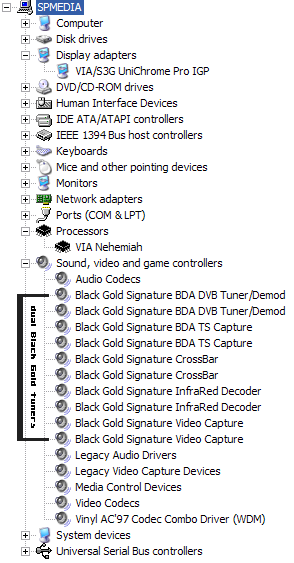New Performance
The CN400 core logic bring S3's UniChrome Pro IGP to EPIA-SP. UniChrome's Chromotion CE engine supports hardware MPEG-2 and MPEG-4 decode assist (not total offload from the CPU). Based on S3's years-old Savage 3D processors, UniChrome isn't anything worth talking about in terms of 3D performance, although it's good enough for the requirements of an MCE2005 PC in terms of basic 3D acceleration and CPU video assist, and with its own 16 byte path to the memory controller doesn't have to suffer too much when accessing memory.Accessing system memory is something it has to do constantly, since it has no local framebuffer and only a small texture memory cache. Access to the FastStream64 controller with a native path outside of the CPU's own interface, and the ability to map up to a 64MB memory space gives plenty of TV and DVD decode performance.
Feeding the EPIA-SP a DDR400 memory module (as Tranquil should be doing in production systems in March) gives you a fine boost in offload performance compared to what you'll see with a DDR333 DIMM (as supplied in the preview unit) and greater than PAL resolution DivX video played with nary a hitch or stutter (just using the Nehemiah!). What the MPEG-4 offload engine can't do is accelerate WMV9 video decode, which is a shame. The world is still waiting for MPEG-4 component drivers for CN400/Chromotion CE which is why the CPU played back the DivX clip in my short, successful test, but even when they appear, WMV9 decode will remain a CPU-only task if you use on-board CN400 video.
That's alright for WMV9 video in PAL resolutions, the Nehemiah-core C3 doing that just fine at 1333MHz with all my test clips (which the 1200MHz chip did too). Feed it hi-def video in that format (remember that WMV9 is an MPEG-4 variant) and the processor isn't up to the job.
That's maybe the last performance hurdle for EPIA to overcome, though. The EPIA-SP didn't suffer the subtitle problem that the EPIA-MII + FX 5200 did, hard disk spin down was never an issue and TV resumes just fine after hibernation, Tranquil suggesting that the hardware overlay not being recreated on wake-up was an NVIDIA problem suffered in recent drivers.
With only hi-def video decode a problem [complete CPU usage map of WMP10 replaying the 1080i T2 sample] during my testing, and that's without a discrete graphics card, the EPIA-SP does well and the CN400 bridge is largely responsible.
Tranquil hinted to me yesterday that running RAID0 on the SATA ports would speed up general MCE2005 usage, so I scavenged a pair of Raptors from other systems and hooked them up outside the case (so I can't comment on heat performance with RAID). While I couldn't reinstall the OS to the array, I was able to point various data stores there and while it's just a subjective analysis, MCE2005 response did feel slightly better. Remember, with a 64MB UniChrome buffer setup, you're left with 448MB for the OS.
Recording from one tuner and playing back TV on the second was fine and monitored CPU usage a one tuner scenario was barely less and performance was very similar, indicating that both tuners aren't killing the PCI bus too much (which I've had Conexant broadcast processors do in the past), or the CPU.
It's also annoying that despite the tuners being capable of tuning DAB radio, MCE2005 has no software component for that so it goes unused. Basic £40 Freeview set-top boxes can manage that function.
My issues with MCE2005 as an interface and operating system (which lie outside of it simply being used as a media system) don't disappear, but the majority of my bigger grumbles with the performance go away with EPIA-SP, provided Tranquil ship DDR400 memory modules which I'm sure they will.
Device manager shows all the components for this new performance.










